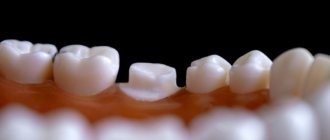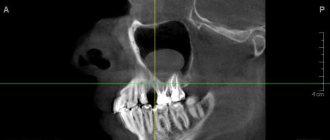October 31, 2017
Chips are a problem that occurs much more often than it might seem at first glance. A piece breaks off, as a rule, on the front teeth, because they are not designed for heavy loads, but it is with them that we most often bite off hard bones, it is on them that we fall unsuccessfully or damage them due to bad habits (for example, gnawing seeds or biting the tip of a pencil ).
Many patients are interested in how to restore chipped front teeth. We present to you the three main methods that a dentist can offer. The editors of the UltraSmile.ru portal decided to figure out which of them is the best in terms of price-quality ratio.
Artistic extension
Artistic restoration is a method in which chips are restored using various restoration materials (we are talking about composites - they are also used for classic tooth filling). They allow you to replicate the shape, color and transparency of a natural tooth.
Such restoration is carried out directly in the patient’s mouth - using polymers or composites, the doctor restores the integrity of the tooth, literally building it up. The advantage of the technology is speed (they came to the doctor and left with new teeth), as well as the price. The cost of restoration is from 2-3 thousand per element.
Artistic restoration
Among the disadvantages is not too long service life. The extended tooth will last about 3-5 years. At the same time, it will have to be protected from stress and regularly polished so that the composite remains smooth - otherwise, if there are micropores, bacteria, plaque and coloring pigments of products will accumulate in them. The color of the restoration will change.
On a note!
If the chip is strong, that is, almost to the root, you can install a pin or stump inlay inside the canals, and then build up the crown using composites.
This option will extend the service life for several more years. Video review from a patient about artistic restoration of anterior teeth.
Dental restoration methods: direct and indirect
Direct artistic restoration of teeth using the latest generation composite material. The procedure is performed on the patient's first visit. The tooth shape is created with special tools to form the complete anatomy. In 1-1.5 hours you will leave us with a new, beautiful smile!
Indirect aesthetic restoration of teeth. It is performed using veneers or inlays. These structures are made in our own laboratory using ultra-precise casts. Thanks to this, maximum predictability of the result is achieved.
Direct restoration of teeth with composite material (filling)
Direct composite restoration is performed using the latest generation filling restoration material (photopolymer). It is carried out immediately, at the first visit to the dentist’s office. Today, this is the fastest and most affordable option for removing minor defects (chips, crevices, carious destruction, etc.).
Artistic restoration of teeth using the direct method consists of the following stages:
- Free consultation and examination (including x-ray).
- Coordination of the treatment plan (selection of material, taking into account the color of the restored fragment).
- Professional oral hygiene (all plaque is removed from tooth surfaces for better adhesion).
- Anesthesia (for maximum patient comfort during the procedure).
- Isolation of an incisor or molar (installation of a rubber dam).
- Degreasing the tooth surface with special compounds and applying adhesive (glue).
- Application of photopolymer (layer-by-layer).
- Correction, grinding and polishing.
The service life of such a restoration is 3-4 years.
Important! To ensure that after restoration with a composite filling material it does not lose its original shade, it is necessary to visit the dentist’s office 2 times a year and undergo a comprehensive procedure for professional oral hygiene.
Direct aesthetic restoration of teeth - advantages and disadvantages
Advantages
- Relatively inexpensive. In our clinic, the price for such a service starts from 4,500 rubles
- High aesthetic results are guaranteed.
- Treatment is carried out in 1 visit.
- Composite materials can be repaired and replaced.
- The procedure is so safe that it is recommended even for children.
- A universal solution that eliminates the following problems: caries, irregular tooth shape and color.
Flaws
- Short service life - only 3-4 years
- In the absence of proper oral hygiene, the composite absorbs coloring pigments, which leads to loss of shine and its highlighting against the background of other teeth.
Veneers and Lumineers
Veneers are thin veneers made from ceramic or zirconium. They are fixed on the front part and completely hide almost all imperfections - gaps in the row, discoloration, pigmentation, as well as small chips and cracks. Naturally, this option is more expensive. By the way, if there is a large chip, the tooth will still have to be restored first, namely, extended. But the technology can be carried out more mediocrely, using less expensive options, since it will be covered with overlays.
Lumineers
The cost of installing veneers is from 20 thousand per tooth. Such onlays are installed in 2 visits - during the first visit, the enamel is prepared (part of it is ground down for a better fit of the veneers), during the second, the onlays are directly fixed.
“I’ve been wanting to get veneers for a long time, because there were several chips! There were extended restorations everywhere. The only thing that put me off was the price - it is, of course, very high, because you have to put it on several teeth at once to make it look beautiful. Just recently I met a dentist who offered me a very good discount))) I am simply incredibly happy with the result!!! I'm not ashamed to smile, everything looks great, so I recommend it to anyone who has doubts. The main thing is to find your doctor!!!”
from correspondence on forums
Direction: Installation of veneers
Ximera
Treatment methods. Diagnostics
In order to identify microcracks, the dentist from Roden carries out a thorough examination of the dentition, as well as the affected soft tissues. Before determining what to do if a tooth chips,
Current diagnostic methods are prescribed. In some cases, modern coloring solutions are used to make cracks visible. An effective detection method, however, remains an x-ray and a high-precision microscope.
Important:
Independent identification of microcracks is possible by drinking multi-colored drinks (coffee or tea), which immediately indicate a split in a healthy tooth.
Implemented treatment methods
Rodin practices innovative treatment methods, the main of which are:
· Remineralization of enamel. If there are significant cracks in the enamel, the surface is restored using special composites and varnishes. It is noteworthy that it is not recommended to coat the enamel with the substance more than once a year;
· Plates-veneers. Anterior cracks are covered using ceramic plates that can mask significant cracks in the enamel. Veneers are installed exclusively on previously prepared teeth: the grinding method is used;
· Splits of horizontal and vertical orientation. Elimination of splits is ensured by special crowns installed by clinic specialists. Before starting the procedure, filling and depulping are carried out;
· Complication in destruction. Internal cracks require a special approach: prosthetics are performed on the diseased tooth. Otherwise, it must be completely removed.
Crowns for teeth
Another option to solve the problem is crowns. They completely cover the damaged tooth, or rather, its top. They are used in cases where the chip is so severe that neither extensions nor veneers are suitable.
For front teeth, it is better to choose crowns without metal in the base - such material can show through in the light and the restored tooth will look dark. Therefore, preference should be given to ceramics or zirconium. The cost of such prostheses is from 15 thousand rubles.
Crowns for front teeth
Causes
- Dental trauma. Falls and impacts are the main reason why chips and cracks occur in perfectly healthy teeth;
- Negligence towards one’s health and bad habits (opening beer bottles with teeth, cracking hard nuts with them, gnawing hard objects, etc.);
- Demineralization of tooth enamel. A process that leads to weakening of enamel and increased risk of injury;
- Carious lesions. They damage the structure of enamel and dentin and thereby make the tooth more vulnerable to mechanical stress. Depulpation completely “kills” the tooth: the tissues, not receiving nutrition from the pulp, become very fragile;
- Bite abnormalities. Cause improper load distribution, which increases pressure on individual teeth or areas of the dentition;
- Incorrect filling. Due to an incorrectly installed filling, the chewing tooth often chips;
- Poor nutrition and poor hygiene. An indirect cause that affects dental health in general;
- Weakened immunity, bad genetics.
Which method is better?
To summarize: artistic extensions are cheap, but not very durable. Veneers need to be installed on several teeth at once in order to fully transform your smile, which means it will be quite expensive. Crowns allow you to restore even one tooth, and you can choose a very aesthetic option. Which of the following should I choose? It’s difficult to say - only a doctor can give an exact answer, knowing and seeing the initial situation (and also taking into account your financial capabilities). Therefore, we still recommend trusting your choice to your orthodontist, who will be able to offer a solution that is the most optimal in appearance, quality and affordable.
Options for restoring chipped front teeth
Notice
: Undefined variable: post_id in
/home/c/ch75405/public_html/wp-content/themes/UltraSmile/single-item.php
on line
45 Notice
: Undefined variable: full in
/home/c/ch75405/public_html/wp-content /themes/UltraSmile/single-item.php
on line
46
Rate this article:
veneers, lumineers, chips
Restoring a chipped tooth
Most patients after mechanical damage have a logical question: how to fix a chipped tooth? The treatment method for chipped teeth depends entirely on the type and degree of damage. Today, technology makes it possible to restore a chipped tooth of almost any severity, but this requires resorting to complex and expensive therapeutic and orthopedic procedures.
| Problem | Description of methods |
| Light chips and cracks (treatment of chipped tooth enamel) | For minor enamel cracks, mineralization and fluoridation are used to restore its protective functions and prevent the cracks from deepening. For minor damage, filling is usually not required. If there is no risk to functionality and aesthetics, then the doctor suggests grinding down the chipped tooth. |
| Moderate chips | If the damage has affected the dentin, then filling is no longer possible. The same can be said about severe chips and cracks in the enamel. Often, chipped teeth are built up with composite materials and restored with inlays. |
| Heavy enamel chips. | If the pulp has been affected, then before starting to restore the chipped tooth, it is necessary to carry out endodontic treatment with removal of the pulp and filling of the canals. In case of chips under the gum and deep clefts of the tooth, its complete or partial removal with subsequent installation of a crown or implant may be indicated. In situations where a large part of the tooth is missing, installing veneers and inlays is almost impossible. |











